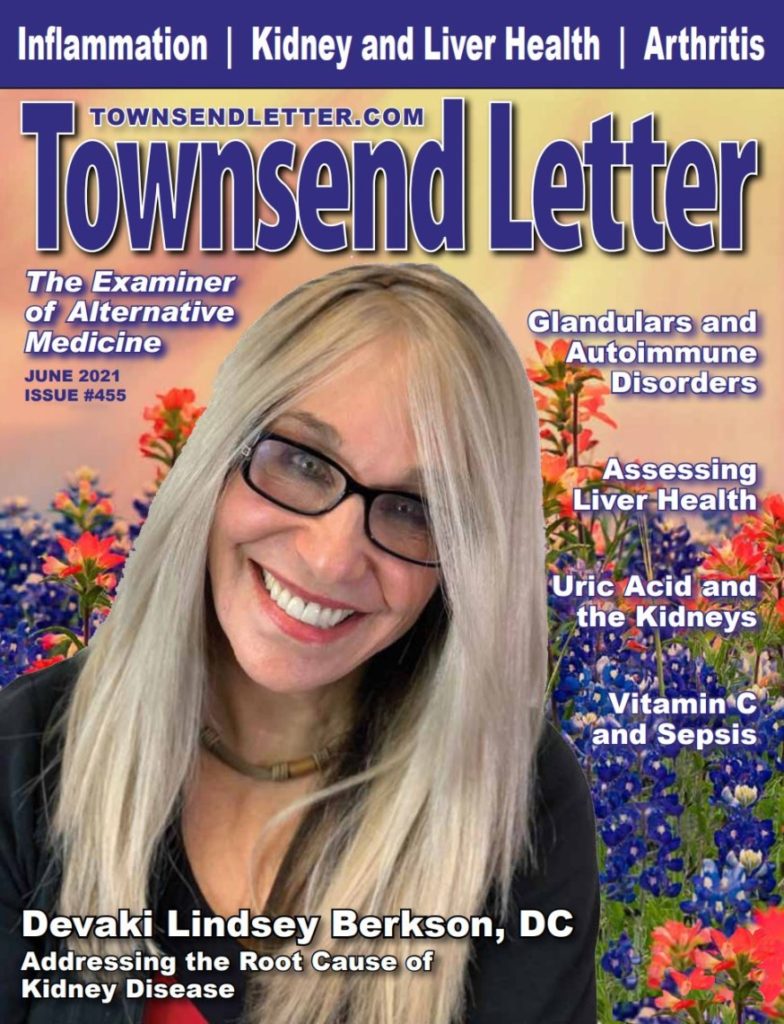…article continues:
Asymmetric dimethylarginine (ADMA)42 inhibits nitric oxide synthases and, when elevated, extremely enhances oxidative stress on the kidneys and cardiovascular system. Increased plasma ADMA levels are strong and independent risk factors for chronic kidney disease as well as various cardiovascular diseases such as hypertension, coronary artery disease, atherosclerosis, diabetes, and heart failure. After kidney failure there are dramatic increases of systemic ADMA and L-NMMA. These are kidney-nasty molecules.
N-monomethyl l-arginine (L-NMMA) works similarly to ADMA and elevates while the kidneys are declining and then increases enormously after kidney failure.
Symmetric dimethylarginine (SDMA)43—both asymmetric and symmetric dimethylarginine—are very toxic, non-proteinogenic aminos, which are uremic toxins that inhibit nitric oxide (NO) production and play multifunctional roles in many human diseases, especially kidney and heart.
Potassium and uric acid, of course, need to be tracked meticulously, and there are many nutritional interventions to correct these without having to severely limit certain foods, like vegetables.
Cystatin-C44,45 monitors renal inflammation more sensitively than eGFR and is a great way to see if the intervention we are using is working.
When I ran these kidney damaging molecules on myself, I was shocked to see “all” of them in dangerous elevated ranges. All the while, my nephrologist kept saying I was stable and there was nothing left to be done. Yet…
- My TMAO, which should be below 6, was over 66.
- My galectin-3, which should be under 17, was 55.
- My cystatin C was high.
- Everything was high.
- But my kidney doctor said I was stable and fine and no worries.
- My labs looked like I might go into renal failure within a few years, if one reads all the data behind these molecules.
- But I was instructed to keep doing what I am doing and just keep coming back to the office once a year to get basic blood tests and say hi.
My mentors at Tulane, where the environmental estrogen think tank was, confirmed that many DES offspring are high in many of these molecules. It wasn’t a toxic gut that was elevating my TMAO; it was the DES in the womb that up-regulates the enzyme that makes it in the liver.
So Now What?
Even if the seed of my kidney issues in adulthood were sown inside the womb, what could I do to save my lonely solo kidney and protect my life?
I sleuthed the literature for how to lower or optimize each of these molecules. It took dietary changes and nutrient interventions. I had to be careful of how many nutrients I used and which ones, as many of these are processed through the kidney. I had to be very careful how much magnesium and minerals to take in, how to keep the kidney alkaline throughout the day, as kidneys love alkaline, and how to turn the flow of the clinical river without making things worse.
I made a lot of changes, even though by all standards I already ate really well. I gave up animal products and ate almost no protein except veggies and beans for three months to give my lone kidney some breathing space.
In addition, I took specific nutrients that the peer review research suggested could normalize levels. For example, I used modified citrus pectin to bring down the galectin-3. My uric acid was extremely high, so I went on herbs, quercetin, and tart black cherry juice, as well as vitamin C, and gave up all animal products. For a while. I monitored my potassium and let this guide my veggie intake. And re-ran my labs. And, within 10 months…all were normal!
I hadn’t felt ill. But now that these “molecules of mass destruction” were back in Goldilocks ranges, I felt fantastic. You don’t know when you are feeling less and less until you feel better more and more.
Who discovered these molecules, and why don’t more doctors test and treat them?

The Cleveland Clinic discovered many of these molecules and how they drive the beat of kidney and heart disease. There are over 4,000 peer review articles on galectin-3 and 1700 articles on TMAO. But still they have not reached most clinical trenches.
The peer review articles on these molecules establish their influence and toxicity when in excess and illustrate how to normalize them through various interventions—dietary and nutrient intervention.
My kidney doctor had never heard of any of these molecules except, of course, uric acid and potassium. I worked in Tulsa, Oklahoma, in 2011 when cystatin C was first recommended by the American Nephrology Association over eGFR, and we ran this kidney test there for $15 a pop. When I tried to order this test in Austin, it costs almost $600. My kidney doctor wouldn’t run it as he said my insurance wouldn’t cover it due to the high cost. I asked if any kidney doctors in Austin run it. He responded without hesitation, “I doubt it.”
I wanted to hear why my kidney doctor didn’t know about any of these exotic molecules of mass destruction. I’ve been going to the same good guy for most of these 16 years and asked how it could be that he didn’t know about these. Dr. Rodriguez shook his head, “My association doesn’t mention them, thus, I am not guided to use them.”
I let out a huge sigh of frustration, “You know, I have been coming to you for 16 years, giving my kidney health into your hands. It’s very upsetting that I have been asking all those years why I can’t turn this around. Have you ever gone home and sleuthed the science to see how this might be happening to me? You know I eat so well, work out daily, do everything right but just keep getting worse. Be honest now, have you ever gone home with me in mind and hit the books?”
“No,” he sighed, “we just don’t know why.”
Well, I am a DES daughter. As it turns out, DES exposure in a developing fetus causes lifelong elevations of many of these molecules, the very molecules that drive kidney disease. But that never came up in our office visits (nor with any other doctor, honestly).
Let’s take galectin-3, for example. When experimental animals are exposed to DES in the womb, they develop excessive levels of galectin-3, which promote the development of kidney tumors.46
My kidney doctor shook his head. “Look, why don’t you do what you are planning on doing and retest your function in so many months. If you drop to stage two from stage three, I’ll change the way I practice, and I will teach functional nephrology.”
That’s what he said.
I huffed, “You can’t teach functional medicine. You’d have to study it first! But if you see that I improve, why don’t you and I together form a functional nephrology module and train others?”
To Dr. Rodriguez’s credit, he agreed. And he only required I improve by only one stage. But when I ran my labs 10 months later, I had recovered to “completely normal function,” even with one kidney, for the first time in 16 years.
I have to go back and see what he says. Will he add testing these molecules to his practice? Will he and I team up to spread the “functional nephrology” word?
He’s a smart younger man. He and his wife have gone vegan. They are cleaning up their diet. Why didn’t he know, as a kidney specialist, how excessive levels of TMAO can damage the kidney and how vegetarian-type diets can dramatically and quickly lower this molecule of mass destruction? Yikes!
I have a young 11-year-old type-1 very brittle (hard to control) diabetic, with worsening renal issues and chronic blood and protein in his urine. He has been seen by his nephrologist, a urologist, and his family doctor. None of them understand why this is happening. They continue testing and find nothing to give a drug for. The boy keeps urinating blood and having pain. And, of course, his mother is going out of her mind with worry.
So, I encouraged his mother to ask his nephrologist to run these molecules of mass destruction. Stunningly, the nephrologist refused. He said he didn’t know what these were or how to interpret them. The mother said I could work with him to show him what I have been finding out.
He simply refused to be a team player or to work with my office on this. Although his office had no answers, he was not willing to take a look at other possible causes and answers, despite the fact that there are thousands of peer review articles linking these molecules to kidney disease. That’s how so much of this stands today.
I got so angry; I could grind my teeth to powder. What is a renal patient to do besides watching their kidney function worsen?
Functional medicine tries to identify “root cause” issues that drive disease, such as these molecules driving kidney disease. But presently there are no functional medicine renal modules anywhere in the world.
I have been offering to start teaching modules and CME courses in this. So far, the main certification courses for functional medical practitioners have not agreed to my proposals. Many doctors are not interested in renal care, as it seems to be the “rabbit hole” of medicine where patients just get worse and that’s expected. And accepted.
Well-intentioned kidney doctors can’t do much other than give you meds, tell you to drink more water, and track your progress as you most likely continue to decline.
I am presently working part-time at the Naples’s Center for Functional Medicine. (I am not able to fully pull myself away from my “Keep Austin Weird Lifestyle” in Texas, yet.) I look forward to working with patients with renal decline, to help get them back to normal kidney health. No matter their age.
This article is a start.
Got declining kidney disease? Come see me in Florida.
Be well.






